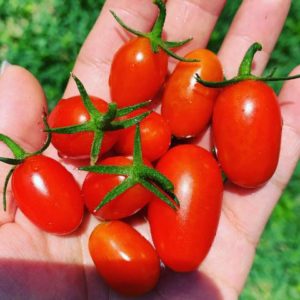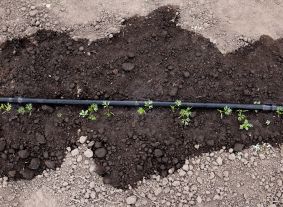Blossom End Rot on Tomatoes
Views: 3879

Im tending some veggie gardens for a local human services agency at two of their residential programs. It’s a great way to expose their clients (folks with mental illness) to how food ends up on their plates. Very rewarding work. And the gardens are coming along very nicely. Except one garden has the worst outbreak of blossom end rot on tomatoes that I’ve ever seen. When I first noticed the telltale darkening of the developing tomatoes’ blossom end, I suspected blossom end rot. My parents would occasionally have this on their tomatoes, so I was somewhat familiar with the signs.
Prevention Fertilizer
As soon as I spotted it, I knew to seek out and purchase a fertilizer specially formulated for tomatoes. Tomatoes require more calcium and magnesium than the average fertilizer provides. Sure, tomatoes need nitrogen, potassium, and phosphorus, the trifecta in NPK prominently displayed on most fertilizer bags. But other nutrients are just as critical, as you quickly come to realize when blossom end rot breaks out in your garden.
Okay, maybe I should have begun fertilizing the tomatoes right off the bat when we planted them. But who knows? My own garden’s tomatoes look fine. The tomatoes in the other gardens look fine. Once I spotted the problem in one garden, I gave them all a dose of the fertilizer. In this garden, something wasn’t quite right.
I applied the fertilizer as directed. The following week, the tomato plants themselves looked odd. Leaves were starting to roll upward, some were developing dark stems. They looked sick and sad. Blight, I thought. Its gotta be blight!
I was on vacation the next week, but I instructed helpers to fertilize again (as directed, every other week) and keep an eye on things. The following week (this week), the tomato plants themselves looked much better. Definitely not blight. A desperate posting of photos of stricken tomatoes on my Facebook page confirmed the blossom end rot diagnosis.
Other causes of blossom end rot
On the Facebook, someone asked me whether these plants were grown in containers, as this often happens in containerized vegetables. These rotting tomatoes were grown in raised beds with composted manure with added peat. So, technically, they are grown in containers.
Another factor to keep in mind is the soil’s pH. The beds may have plenty of nutrient in the soil, but it could be locked up or unavailable for absorption by the roots due to incorrect pH. (Believe me, my eyes start glazing over when the conversation ventures in this direction, too.) If the soil pH is less than 6 on the acidic side, this may be the reason our tomatoes are suffering from a lack of calcium and magnesium.
What to do? First, check the soil pH. If its below 6, raise the pH by adding lime. See if that helps. If pH is above 6, add more fertilizer with calcium and magnesium. Apparently there is a liquid form (Biomin Calcium) that is easily and quickly absorbed.
And then plan to get a jump on tomato fertilizing for next year.
Meet Ellen Wells
When you’re raised on a farm, you can’t help but know a thing or two about gardening. Ellen Wells is our expert on edible gardening.…
Ellen's Recent Posts

Asparagus






